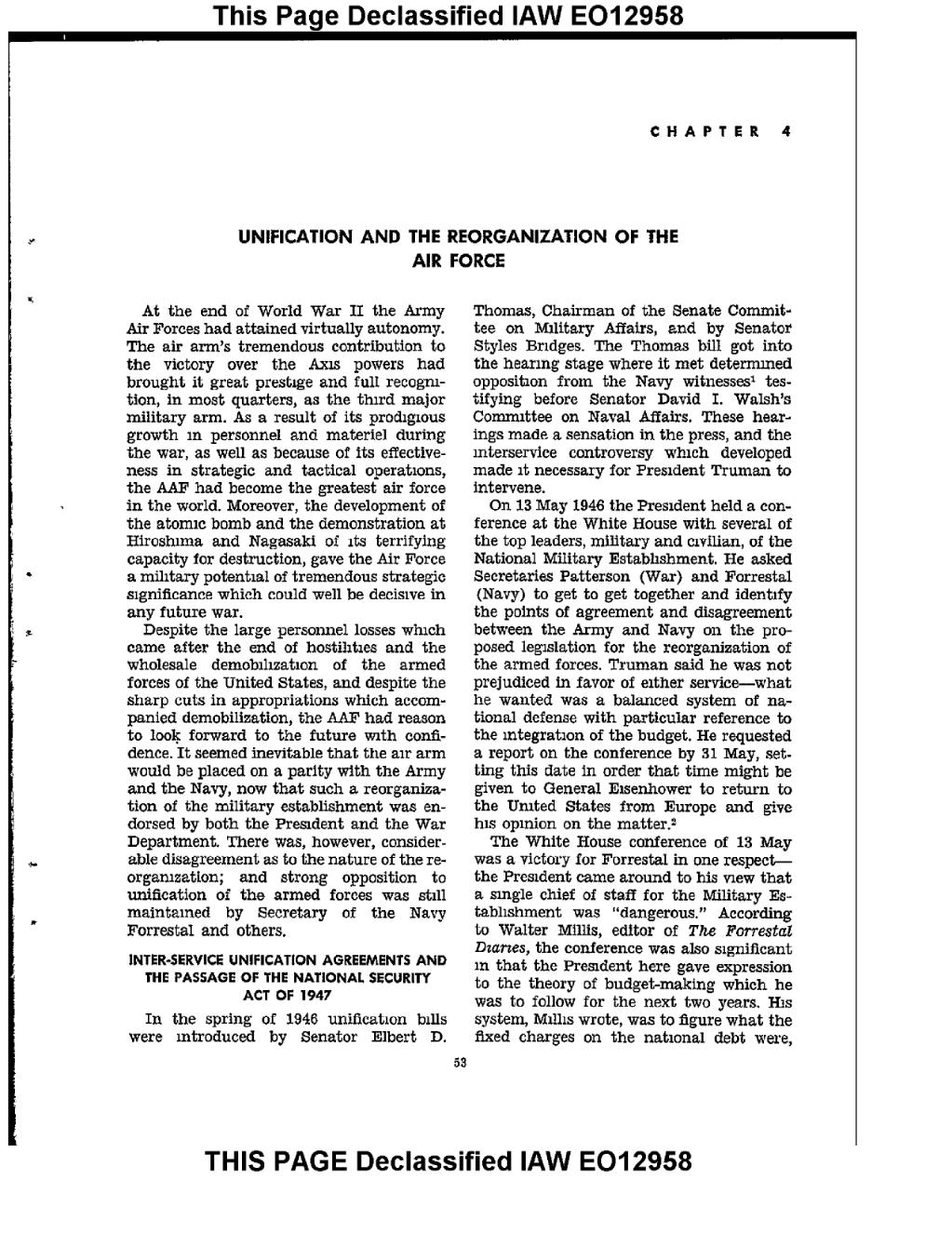�This Page Declassified lAW EO12958 CHAPTER 4 UNIFICATION AND THE REORGANIZATION OF THE AIR FORCE At the end of World War II the Army Air Forces had attained virtually autonomy. The air arm's tremendous contribution to the victory over the Ax?s powers had brought it great prestige and full teeogre- lion, in most quarters, as the third major military arm. As a result of its prod?gmus growth m personnel and matoriel during the war, as well as because of its effective- ness in strategic and tactical operations, the AAF had become the greatest air force in the world. Moreover, the development of the arcram bomb and the demonstration at Hiresfnma and Nagasaki of ?ts terrifying capacity for destruction, gave the Air Force a mihtary potentml of tremendous strategic mgnificance which could well be decisive in any future war. Despite the large persormel losses winch came after the end of hostiht?es and the wholesale demob?hzatmn of the armed forces of the United States, and despite the sharp cuts in appropriation? which accom- panied demobilization, the AAF had reason to look. forward to the future wath confi- dence. It seemed inevitable that the a?r arm would be placed on a parlty with the Army and the Navy, now that such a reorganiza- tion of the military establishment was en- dorsed by both the President and the War Department. There was, however, consider- able disagreement as to the nature of the re- orgamzation; and strong opposition to unification of the armed forces was st?ll main?mned by Secretary of the Navy Forvestal and others. INTER-SERVICE UNIFICATION AGREEMENTS AND THE PASSAGE OF THE NATIONAL SECURITY ACT OF 1947 In the spring of 1946 unificatmn b?11? were introduced by Senator Elbert D. 53 Thomas, Chairman of She Senate Commit- tee on iVblitary Affairs, and by Senator Styles Bridges. The Thomas bill got into the heanng stage where it met determined oppositaon from the Navy witnesses ? tes- tifying before Senator David I. Walsh's Corertuftee on Naval Affairs. These hear- ings made a sensation in the press, and the ?nterservice controversy winch developed made ?t necessary for President Truman to intervene. On 13 May 1946 the Promdent held a con- ference at the White House with several of the top leaders, military and mvilian, of the National Military Estabhshment. He asked Secretaries Patterson (War) and Forrestal (Navy) to get to get together and identify the points of agreement and disagreement between the Army and Navy on the pro- posed leguslation for the reorganization of the armed forces. Truman said he was not prejudiced in layor of e?ther service--what he wanted was a balanced system of na- tional defense with particular reference to the integrafinn of the budget. He requested a report on the conference by 81 May, ting this date in order that time might be given to General Emenhower to return to the Urnted States from Europe and give h?s opinion on the matter.: The White House conference of 13 May was a victm?y for ForrestaI in one respect? the Promdent came around to his wew that a single chief oi staff for the Military tablmhment was "dangerous." According to Waiter Millis, editor of The Forrestai Dmr?e3, the conference was al?o s?gnificant m that the Promdent here gave expression to the theory of budget-making which he was to follow for the next two years. H?s system, M?!hs wrote, was to figure what the fixed charges on the natrenal debt were, THIS PAGE Declassified lAW E012958
